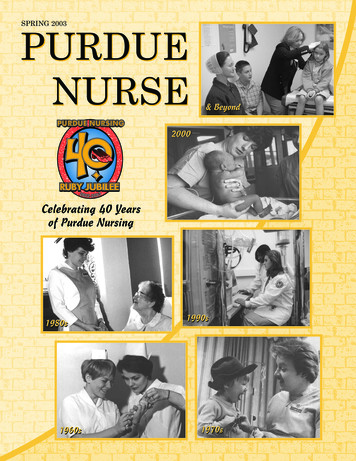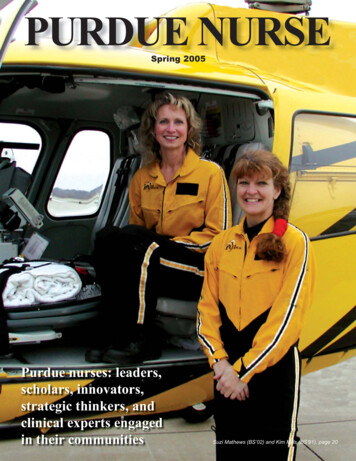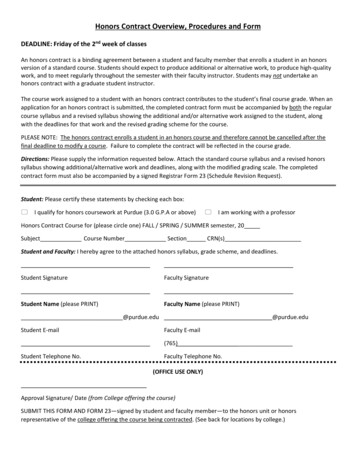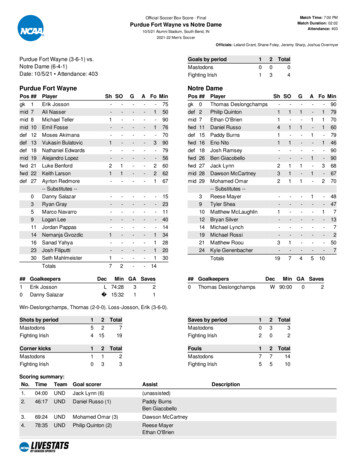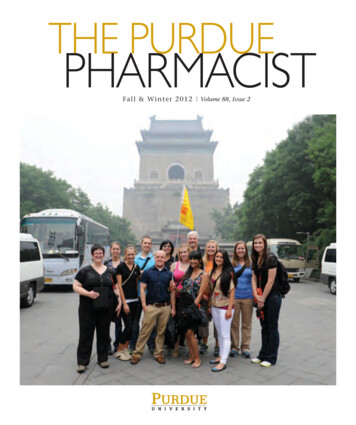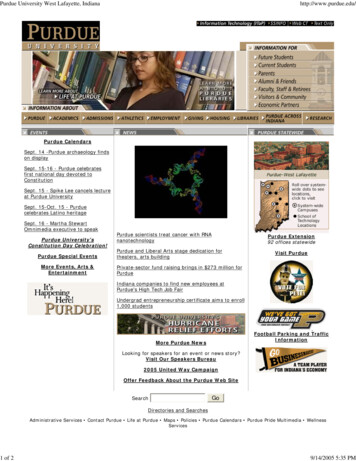
Transcription
Purdue University West Lafayette, Indiana1 of 2http://www.purdue.edu/Purdue CalendarsSept. 14 -Purdue archaeology findson displaySept. 15-16 - Purdue celebratesfirst national day devoted toConstitutionSept. 15 - Spike Lee cancels lectureat Purdue UniversitySept. 15-Oct. 15 - Purduecelebrates Latino heritageSept. 16 - Martha StewartOmnimedia executive to speakPurdue University'sConstitution Day Celebration!Purdue Special EventsMore Events, Arts &EntertainmentPurdue scientists treat cancer with RNAnanotechnologyPurdue Extension92 offices statewidePurdue and Liberal Arts stage dedication fortheaters, arts buildingVisit PurduePrivate-sector fund raising brings in 273 million forPurdueIndiana companies to find new employees atPurdue's High Tech Job FairUndergrad entrepreneurship certificate aims to enroll1,000 studentsFootball Parking and TrafficInformationMore Purdue NewsLooking for speakers for an event or news story?Visit Our Speakers Bureau2005 United Way CampaignOffer Feedback About the Purdue Web SiteSearchGoDirectories and SearchesAdministrative Services Contact Purdue Life at Purdue Maps Policies Purdue Calendars Purdue Pride Multimedia WellnessServices9/14/2005 5:35 PM
Purdue scientists treat cancer with RNA nanotechnology1 of tmlPurdue scientists treat cancer with RNAnanotechnologyWEST LAFAYETTE, Ind. – Using strands of genetic material,Purdue University scientists have constructed tiny deliveryvehicles that can carry anticancer therapeutic agents directly toinfected cells, offering a potential wealth of new treatments forchronic diseases.The vehicles look nothinglike delivery trucks, thoughthat is their function onceinside the body. Instead,these so-callednanoparticles, which areassembled from three shortpieces of ribonucleic acid,resemble miniaturetriangles. The microscopicparticles possess both theright size to gain entry intocells and also the righttriangular particlestructure to carry otherDownload graphictherapeutic strands of RNAcaption belowinside with them, wherethey are able to halt viral growth or cancer's progress. The teamhas already tested the nanoparticles successfully against cancergrowth in mice and lab-grown human cells."RNA has immense promise as a therapeutic agent againstcancer, but until now we have not had an efficient system tobring multiple therapeutic agents directly into specific cancercells where they can perform different tasks," said researchteam leader Peixuan Guo, who is a professor of molecularvirology at Purdue with joint appointments in Purdue's CancerResearch Center, School of Veterinary Medicine and WeldonSchool of Biomedical Engineering. "Physicians have hoped thatnanotechnology might provide a solution to the problem, and it'spossible that the application of these tiny triangles could lead tothe solution.""With these devices, Dr. Guo was able to deliver three differenttherapeutic agents into a cell at the same time," said Jean Chin,a scientist at the National Institute of General Medical Sciences,which is part of the National Institutes of Health. "This is anincredible accomplishment that points to the versatility andpotential medical value of these nanoparticles."The research appears in two related papers being published inthe scientific journals Nano Letters and Human Gene Therapy.Members of Guo's research team are from Purdue, the Universityof Central Florida and the University of California, Riverside,including Songchuan Guo, Annette Khaled, Feng Li, SulmaMohammed and Nuska Tschammer.Guo's team created their nanoparticles by linking togetherdifferent kinds of RNA, a task that their previous research has9/14/2005 5:30 PM
Purdue scientists treat cancer with RNA nanotechnology2 of tmlgiven them ample opportunities to practice. Several years afterbuilding a tiny "motor" from several strands of RNA that mimicthose in a bacteria-killing virus called phi29, the team learnedhow to manipulate these stringy molecules into different shapes,including rods, triangles and arrays."We speculated at that time that these shapes would be usefulpurely as physical scaffolding on which more sophisticatednanodevices could be constructed," Guo said. "But RNA, whichcarries genetic messages within cells, also has many therapeuticfunctions. We realized that if we built different kinds oftherapeutic RNA onto the RNA scaffolding and created a singlestructure, we might be able to respond to several challenges thathave confronted the medical field."RNA molecules come in many variant forms, and the sort thatthe team mimicked from the phi29 virus – called pRNA – alsocan be linked to other types of RNA to form longer, hybridstrands with properties the researchers could assign."We looked around for RNA strands that would behave in certainways when they encounter a cancer cell because each of themneeds to perform one step of the therapy," Guo explained. "Aneffective agent against cancer needs to accomplish severaltasks. It needs first to recognize the cancer cell and gain accessto its interior, and then it needs to destroy it. But we'd also likethe agent to leave a trail for us, to mark the path the moleculehas taken somehow. That way, we can pinpoint the location ofthe cancer and trace the outcome after the treatment."To accomplish these tasks, the team turned to other forms ofRNA that can interfere with the goings-on inside cells. The teamsorted through a variety of RNA forms that have shown promisefor disease treatment and found three that could perform each ofthe desired tasks. One example is "small interfering RNA," orsiRNA, which deactivates certain genes in cells. The others areRNA aptamers, which bind to cancer cell surface markers, andribozymes, which can be designed to degrade specific RNA incancer cells or viruses."We linked each of the three therapeutic strands with a piece ofpRNA, forming three hybrid strands," Guo said. "Then, usingtechniques we learned from our earlier work, we were able tocombine all three into triangles that are between 25 and 40nanometers wide. This is the Goldilocks size for any nanoparticlethat is to be used in the body – not too big, not too small."Particles larger than about 100 nanometers are generally toolarge to pass through cell membranes into the cell's interior, Guosaid, and the body has a hard time retaining particles smallerthan 10 nanometers. But the tiny triangles fit, and they workedwell enough to interrupt the growth of human breast cancer cellsand leukemia model lymphocytes in laboratory experiments."One characteristic of cancer cells is that they do not stopgrowing, which is one reason tumors develop," Guo said. "Onceinside, the siRNA essentially instructs the cells to 'stop notstopping.' The nanoparticles had done their work on the breastcancer cell cultures within a few days."Additionally, the team found that the nanoparticles completelyblock cancer development in living mice. A group of mice thatwere in the process of developing cancer were tested with thenanoparticles, and they did not develop the disease. A secondgroup that was tested with mutated inactive RNA all developedtumors.9/14/2005 5:30 PM
Purdue scientists treat cancer with RNA nanotechnology3 of tml"The results are very promising, but we still have several hurdlesto jump before we can test this therapy on people," Guo said."First and foremost, we must ensure that it is as safe as wethink it is. Some RNA can be toxic to noncancerous cells as well,and though our nanoparticles appear to go straight to the cancercells where we want them to go, we have to be sure they do notgo anywhere else before we can inject them into a livingperson."Stability of the RNA also is a factor the team must consider.Although they previously published data indicating that phi29RNA nanoparticles are more stable than other RNA, Guo said theteam still needs to find better ways to protect the RNA fromdegradation by enzymes in the body.Although the group still needs to prove the safety of their tinycreations, Guo said, they remain confident that their work is amilestone for medical nanotechnology. The team has alreadyobtained further results that could help create safer RNAnanoparticles."Many studies have shown that therapeutic forms of RNA, suchas siRNA or ribozymes, could be put together to kill cancer, butthe main obstacle has been finding the delivery method that canbring them to specific cells simultaneously," Guo said."Nanotechnology is beginning to pay off here in that it may haveprovided us with a solution to the problem. We hope to enhancethe work we have done so far and refine it for human trials."The team's work is supported in part by grants from the NationalInstitutes of Health and the Department of Defense.Guo is affiliated with Purdue's Cancer Center and BirckNanotechnology Center.The Cancer Center, one of just eight National CancerInstitute-designated basic-research facilities in the UnitedStates, attempts to help cancer patients by identifying newmolecular targets and designing future agents and drugs foreffectively detecting and treating cancer.The Birck Nanotechnology Center is located in Purdue's newDiscovery Park, located on the southwestern edge of campus.Programs include undergraduate teaching, graduate researchand technology-transfer initiatives with industry partners.Scientists in biology, chemistry, physics and several engineeringdisciplines participate in the research.Writer: Chad Boutin, (765) 494-2081, cboutin@purdue.eduSource: Peixuan Guo, (765) 494-7561, guop@purdue.eduPurdue News Service: (765) 494-2096;purduenews@purdue.eduPrevious news stories on Guo's research:RNA could form scaffolding for nanomachinesPurdue researchers connect life's blueprints with its energysourceGRAPHIC CAPTION:This triangular particle, which is about 25 billionths of a meter9/14/2005 5:30 PM
Purdue scientists treat cancer with RNA nanotechnology4 of tmlacross, could become one of nanotechnology's contributions tothe fight against cancer. Three strands of RNA – a close chemicalcousin of DNA – are linked together to form this "nanoparticle,"created in the lab of Purdue University's Peixuan Guo. Each ofthe strands is spliced together from two kinds of RNA – one sortserves as a scaffold and dovetail to hold the particle together;while the other carries a hunter to find cancer cells, a marker todetect the target, or genetic instructions deadly to a cancer cell.The nanoparticles have already proven effective against cancergrowth in living mice as well as lab-grown humannasopharlyngeal carcinoma and breast cancer cells. (GuoLaboratories)A publication-quality graphic is available athttp://news.uns.purdue.edu/images/ 2005/guo-nanoparticle.jpgABSTRACTControllable self-assembly of nanoparticles for specificdelivery of multiple therapeutic molecules to cancer cellsusing RNA nanotechnology (from Nano Letters, Sept2005, Volume 5, November 9, pages 1797-1808.)Annette Khaled, Songchuan Guo, Feng Li, and Peixuan GuoUtilizing RNA nanotechnology, therapeutic siRNA andreceptor-binding RNA aptamer were engineered into individualmotor pRNAs of phi29. The RNA building block harboring thetherapeutic molecule was subsequently fabricated into a trimerby utilizing engineered right and left interlocking RNA loops.Incubation of such nanoscale devices containing receptor-bindingaptamer or other ligands resulted in binding and co-entry of thetrivalent therapeutic particles into cells, subsequently modulatingthe apoptosis of cancer cells and leukemia model lymphocytes.ABSTRACTSpecific Delivery of Therapeutic RNAs to Cancer Cells viathe Dimerization Mechanism of phi29 Motor pRNA (fromHuman Gene Therapy, Sept 2005, Volume 16, No. 9:1097-1109S)Songchuan Guo, Nuska Tschammer, Sulma Mohammed, andPeixuan GuoThe application of small RNA in therapy has been hindered bythe lack of an efficient and safe delivery system to target specificcells. Packaging RNA (pRNA), part of the DNA-packaging motorof bacteriophage phi29(29), was manipulated by RNAnanotechnology to make chimeric RNAs that form dimers viainterlocking right- and left-hand loops. Fusing pRNA withreceptor-binding RNA aptamer, folate, small interfering RNA(siRNA), ribozyme, or another chemical group did not disturbdimer formation or interfere with the function of the insertedmoieties. Incubation of cancer cells with the pRNA dimer, onesubunit of which harbored the receptor-binding moiety and theother harboring the gene-silencing molecule, resulted in theirbinding and entry into the cells and subsequent silencing ofanti/proapoptotic genes. The chimeric pRNA complex was foundto be processed into functional double-stranded siRNA by Dicer(RNA-specific endonuclease). Animal trials confirmed the9/14/2005 5:30 PM
Purdue scientists treat cancer with RNA nanotechnology5 of tmlsuppression of tumorigenicity of cancer cells by ex vivo delivery.It has been reported [Shu, D., Moll, W.-D., Deng, Z., Mao, C.,and Guo, P. (2004). Nano Lett. 4:1717—1724] that RNA can beused as a building block for bottom-up assembly innanotechnology. The assembly of proteinfree 25-nm RNAnanoparticles reported here will allow for repeated long-termadministration and avoid the problems of short retention time ofsmall molecules and the difficulties in the delivery of particleslarger than 100 nm.[Keywords: pRNA, bacteriophage phi29, gene therapy,nanomotor, DNA packaging, hexamer, siRNA, folate, aptamer,receptor mediated endocytosis, bottom-up assembly]To the News Service home page9/14/2005 5:30 PM
virology at Purdue with joint appointments in Purdue's Cancer Research Center, School of Veterinary Medicine and Weldon School of Biomedical Engineering. "Physicians have hoped that nanotechnology might provide a solution to the problem, and it's possible that the application of these tiny triangles could lead to the solution."
